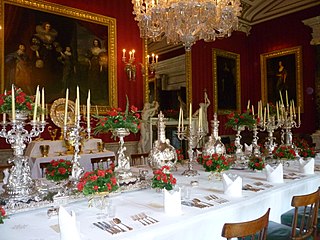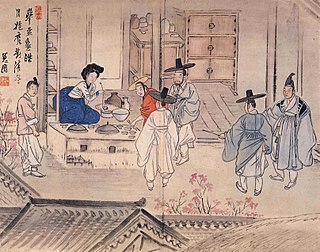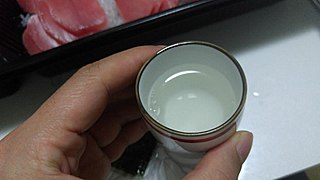
Sake, saké, or saki, also referred to as Japanese rice wine, is an alcoholic beverage of Japanese origin made by fermenting rice that has been polished to remove the bran. Despite the name Japanese rice wine, sake, and indeed any East Asian rice wine, is produced by a brewing process more akin to that of beer, where starch is converted into sugars that ferment into alcohol, whereas in wine, alcohol is produced by fermenting sugar that is naturally present in fruit, typically grapes.

A teapot is a vessel used for steeping tea leaves or a herbal mix in boiling or near-boiling water, and for serving the resulting infusion which is called tea. It is one of the core components of teaware.

A mug is a type of cup, a drinking vessel usually intended for hot drinks such as: coffee, hot chocolate, or tea. Mugs usually have handles and hold a larger amount of fluid than other types of cups such as teacups or coffee cups. Typically, a mug holds approximately 240–350 ml of liquid.

Tableware items are the dishware and utensils used for setting a table, serving food, and dining. The term includes cutlery, glassware, serving dishes, serving utensils, and other items used for practical as well as decorative purposes. The quality, nature, variety and number of objects varies according to culture, religion, number of diners, cuisine and occasion. For example, Middle Eastern, Indian or Polynesian food culture and cuisine sometimes limits tableware to serving dishes, using bread or leaves as individual plates, and not infrequently without use of cutlery. Special occasions are usually reflected in higher quality tableware.

Baijiu, or shaojiu, is a colorless Chinese liquor typically coming in between 35% and 60% alcohol by volume (ABV). Each type of baijiu uses its own type of qū for fermentation to create a distinct and characteristic flavor profile.

Makgeolli, sometimes anglicized to makkoli, is a Korean alcoholic drink. It is a milky, off-white, and lightly sparkling rice wine that has a slight viscosity, and tastes slightly sweet, tangy, bitter, and astringent. Chalky sediment gives it a cloudy appearance. As a low proof drink of six to nine percent alcohol by volume, it is often considered a "communal beverage" rather than hard liquor.

Korean cuisine has a wide variety of traditional alcoholic drinks, known as sul (술). Many of these drinks end with the Sino-Korean word -ju, and some end with the native Korean word -sul. The Sino-Korean -ju is not used as an independent noun.

A masu was originally a square wooden box used to measure rice in Japan during the feudal period. In 1885 Japan signed the Convention du Mètre and in 1886 converted all of its traditional measures to the metric system.

Beer glassware comprise vessels, today usually made of glass, designed or commonly used for serving and drinking beer. Styles of beer glasses vary in accord with national or regional traditions; legal or customary requirements regarding serving measures and fill lines; such practicalities as breakage avoidance in washing, stacking or storage; commercial promotion by breweries; artistic or cultural expression in folk art or as novelty items or usage in drinking games; or to complement, to enhance, or to otherwise affect a particular type of beer's temperature, appearance and aroma, as in the case of its head. Drinking vessels intended for beer are made from a variety of materials other than glass, including pottery, pewter, and wood.

A sakeset consists of the flask and cups used to serve sake. Sake sets are most often in Japanese pottery, but may be wood, lacquered wood, glass or plastic. The flask and cups may be sold individually or as a set.

Cheongju, sometimes romanized as Chungju, is a clear, refined rice wine of Korean origin.

Toso, or o-toso, is spiced medicinal sake traditionally drunk during Japanese New Year celebrations. Toso is also known historically in China.

Mijiu, also spelt michiu, is a Chinese rice wine made from glutinous rice, with the alcohol content ranging between 15% and 20% v/v. It is generally clear in appearance with a balanced taste of sweetness and acidity, similar to its Japanese counterpart sake and Korean counterpart cheongju, and is usually drunk warm like sake and cheongju. An unfiltered form of mijiu containing whole rice grains is called jiǔniàng (酒酿) or láozāo (醪糟), with extremely low alcoholic content and often consumed by children. A type of baijiu called rice baijiu is made via further distillation from mijiu.

A ttukbaegi (Korean: 뚝배기) is a type of oji-gureut, which is an onggi coated with brown-tone ash glaze. The small, black to brown earthenware vessel is a cookware/serveware used for various jjigae (stew), gukbap, or other boiled dishes in Korean cuisine. As a ttukbaegi retains heat and does not cool off as soon as removed from the stove, stews and soups in ttukbaegi usually arrive at the table at a bubbling boil.

Customs and etiquette in Chinese dining are the traditional behaviors observed while eating in Greater China. Traditional Han customs have spread throughout East Asia to varying degrees, with some regions sharing a few aspects of formal dining, which has ranged from guest seating to paying the bill.

A cup is an open-top vessel (container) used to hold liquids for drinking, typically with a flattened hemispherical shape, and often with a capacity of about 100–250 millilitres (3–8 US fl oz). Cups may be made of pottery, glass, metal, wood, stone, polystyrene, plastic, lacquerware, or other materials. Normally, a cup is brought in contact with the mouth for drinking, distinguishing it from other tableware and drinkware forms such as jugs. They also most typically have handles, though a beaker has no handle or stem, and small bowl shapes are very common in Asia.

Huangjiu is a type of Chinese rice wine (mijiu) most popular in the Jiangnan area. Huangjiu is brewed by mixing steamed grains including rice, glutinous rice or millet with qū as starter culture, followed by saccharification and fermentation at around 13–18 °C (55–64 °F) for fortnights. Its alcohol content is typically 8% to 20%.
Shinto weddings, Shinzen kekkon, Shinzenkekkon, began in Japan during the early 20th century, popularized after the marriage of Crown Prince Yoshihito and his bride, Princess Kujo Sadako. The ceremony relies heavily on Shinto themes of purification, and involves ceremonial sake drinking of three cups three times, the nan-nan-san-ku-do. Shinto weddings are in decline. Fewer Japanese people get married, and those who do often choose Western-style chapel ceremonies.

















